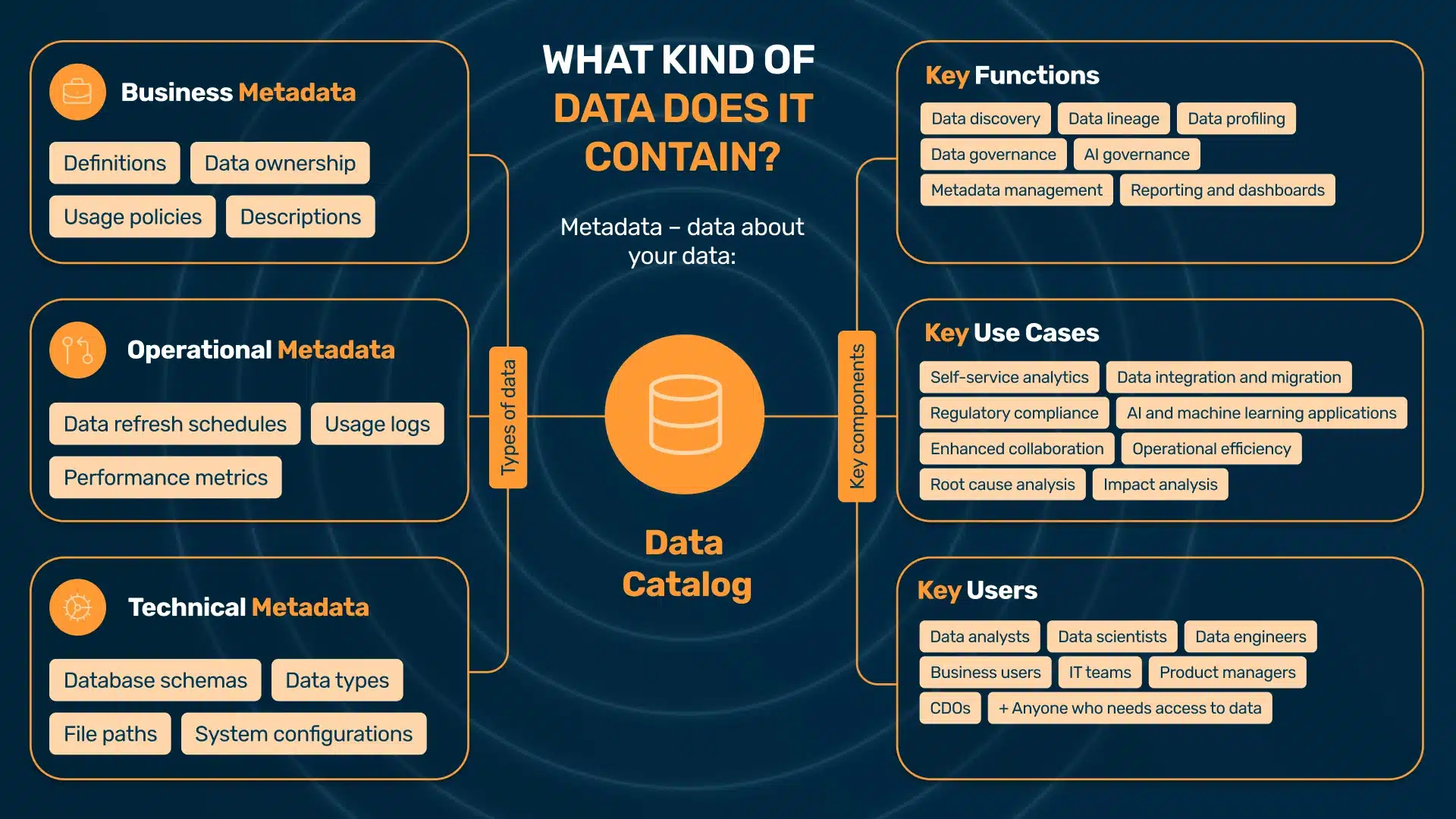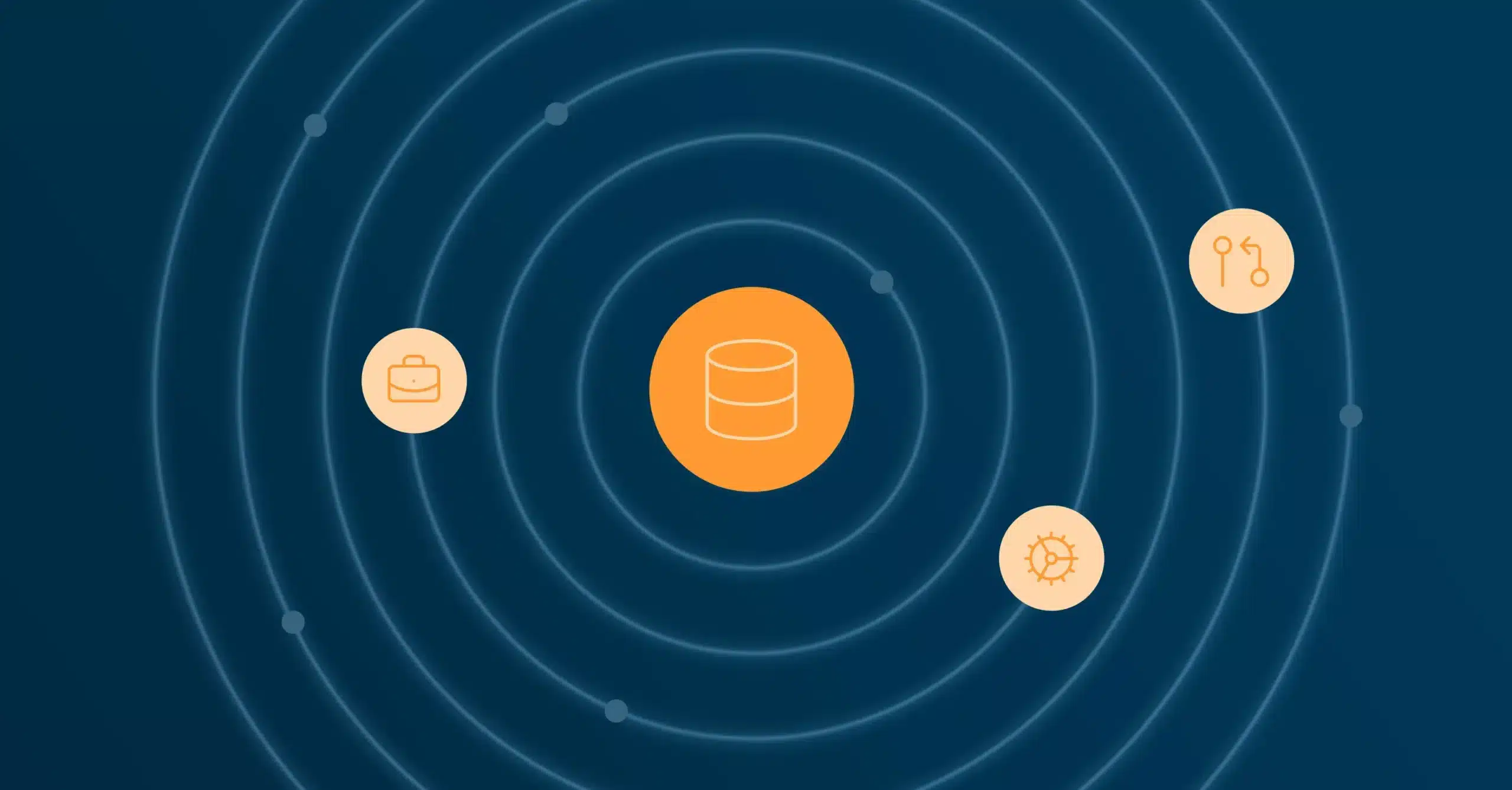If you’re serious about proper data governance in your organization, you will need a data catalog at some point. Here’s what you should know about what a data catalog is and why it’s so essential to make the most of your company’s critical data.
What is a data catalog?
Simply put, this is where all information about your organization’s data (metadata) should be.
A data catalog is not just a tool. It’s the cornerstone of effective data management. It’s the foundation for anything you want to do with your data – from labeling it or grouping it according to specific use cases to managing access to it for the right people.
With the enormous amounts of data enterprises deal with, it’s key to centralize information about it in one place, which is what a data catalog does. And if your data architecture is distributed across multiple catalogs and systems, they, too, need a central catalog as a trusted, single source, which is exactly what we help companies with using the Collibra platform.
Data catalog definition
When it comes to official industry definitions, a data catalog is an organized inventory of a company’s data assets. Its job is to help employees quickly discover, understand, and consume data. A data catalog serves as a metadata repository with details about data assets (like datasets or reports), including their structure, source, usage, and lineage.
Because data catalogs offer a centralized view of data, they make it easier for data professionals and other employees to find the right data assets or datasets without wasting hours searching across servers, databases, BI systems, APIs, folders, or files.
Data catalogs often include search functionalities, data classifications, and collaboration tools. They’re essential for improving data quality, especially as data and data sources multiply by the minute. Business Glossaries additionally help provide more business context to make sure there’s a common understanding of the entire contents of the data catalog.
In Collibra specifically, the Data Catalog application is a catalog of metadata that helps the business and data stewards discover, describe, assemble, and govern data sets.
Within a data catalog, you can integrate data from multiple sources, for example:
- Databases
- Data lakes
- Enterprise applications
- ETL/ELT tools
- BI solutions
- Cloud storage services
- APIs and web services
- File systems and document repositories
- Streaming data platforms
- Master data management (MDM) systems
The metadata in a catalog provides information about details such as data format, structure, date of creation, etc. You can also enrich the integrated metadata with profiling information, data classes, and sample data and link the metadata to their business context.

What is metadata?
To talk about data, especially in a business context, we first need to talk about metadata.
Metadata is simply data about data. It provides descriptive, structural, and administrative details that help people understand and manage data more effectively.
For example, metadata might include a dataset’s:
- name
- creator
- creation date
- format
- size
- description of its contents.
The most popular types of metadata include:
Business metadata
This type of metadata provides context for data from a business perspective. It might include:
- definitions of business terms
- data ownership usage policies
- descriptions for non-technical stakeholders
- different business dimensions such as geography, division/line of business, data vendor, etc.
Technical metadata
Technical metadata describes the technical aspects of data, which are essential for IT teams and data engineers who manage, integrate, or troubleshoot data systems. This might include:
- structure
- format
- storage details.
Some examples of technical metadata are:
- database schemas
- data types
- file paths
- system configurations.
Operational metadata
Operational metadata stores information about the processes and events associated with data usage. It’s particularly useful for monitoring data workflows and identifying potential issues in data pipelines.
It might include details such as:
- data refresh schedules
- usage logs
- system performance metrics.
Why you need a data catalog
Companies generate and store growing volumes of data, so naturally, efficiently tracking, accessing, and using this information becomes increasingly difficult. This is precisely why the role of a data catalog is so crucial. Here is how a data catalog can benefit your company:
Data discovery and accessibility
One of the most significant challenges coming with large data volumes is locating relevant data assets. Without a centralized system, employees might spend unnecessary hours searching through scattered databases, spreadsheets, or files.
With a data catalog, there’s a single, searchable repository where anyone can quickly find and access the exact data they need and focus on putting them to work, regardless of their technical expertise. Because the data has a business context attached to them, it’s also easy for employees outside strictly technical teams.
Data silos
It’s common for large corporations to work in silos – and this includes data silos. Data is isolated in different departments or systems and can’t easily be accessed across the company. This obviously limits its visibility and usefulness. Silos often lead to unnecessary work, inconsistencies in reporting, and missed business opportunities. It’s not uncommon to discover that the same data (like industry reports) is purchased several times by different departments.
A data catalog bridges these gaps and prevents data duplicates. It offers a unified view of all available data assets so departments and teams can stay aligned and work on the exact same data.
Understanding data context
Accessing data is one thing, but you need to understand its purpose, structure, and relevance to actually be able to use it efficiently. When there’s no metadata, it’s easy to misinterpret datasets or not be able to use them correctly – or not even find them in the first place.
Data catalogs provide rich metadata, including descriptions, lineage, relationships, and usage history, putting the data in a valuable context.
Data quality
It’s another common problem: when data comes from different data sources, is stored in different locations, and is not contextualized, inaccuracies, duplicates, or outdated information are bound to happen somewhere down the line.
Data catalogs include features such as data profiling and quality indicators, which help users evaluate how reliable or complete a dataset is before they use it. As a consequence, it helps minimize errors and build confidence in the data.
Regulatory compliance
Another important context for data is regulatory standards across different countries and markets, like GDPR or HIPAA. Complying with those is an extra layer on top of other data management and governance concerns.
A data catalog makes data sources, classifications, and usage policies transparent. It’s easy to track who accesses data and how it’s stored, helping companies reduce the risk of non-compliance.
Reducing redundancy
Redundant data processing and storage are common inefficiencies in large organizations. Teams might not even know that they duplicate efforts to collect or clean data, and this is yet another result of the data silos.
A data catalog offers visibility into existing datasets so teams can reuse and build upon existing work rather than always starting from scratch.
Data catalog functions
As you can see from the challenges alone, a data catalog has multiple functions for a company’s data management processes. Here are some key areas it supports across the organization.
Data discovery
With their search and filtering options, data catalogs help quickly identify and locate datasets within an organization. The metadata is indexed, making datasets easily discoverable and reducing the time spent searching for information.
Metadata management
By their very nature, data catalogs include metadata – data about data. They automatically generate and update metadata so that it’s always accurate and relevant while teams can make sense of it and use its full potential.
Data lineage
Data lineage tracks data’s origins, transformations, and movements as it flows through enterprise systems. Data lineage applied on a data catalog visualizes these pathways, giving team members insight into how data is created, modified, and consumed. This helps immensely with troubleshooting, accuracy, and maintaining trust in data.
Data governance
A data catalog supports data governance by defining roles, access controls, and policies around data usage in a company. Its job is to make sure that data is secure, compliant, and used responsibly, according to organizational policies and regulatory requirements.
Reporting and dashboards
A data catalog often integrates with business intelligence tools. For a company, this means team members can generate reports and monitor key metrics directly from the catalog, which constitutes a unified, consistent data source.
AI governance
These days, AI plays an increasingly crucial role in data management, producing its own challenges. AI data governance focuses on the responsible use of data in machine learning and AI applications. A data catalog helps track data sources, use data ethically, and comply with AI-related regulations.
Data profiling
Data catalogs often include profiling tools that provide summaries, such as data distributions, missing values, and anomalies. Data users can analyze the content, structure, and quality of data and assess how relevant it is to their specific purpose.
Data catalog use cases
Because a data catalog is the foundation of data management, it has plenty of use cases in an organization. Here are some common examples.
Self-service analytics
Data teams are often overwhelmed by requests from business users who need data for analytics or reporting. With a data catalog in place and data products built upon it, employees and teams can find the data by themselves, reducing the dependency on data teams and potential bottlenecks it often causes.
Data integration and migration
Data catalogs are essential during system upgrades, mergers, or migrations. They provide a clear map of data assets, their sources, and dependencies, reducing the complexity and risks associated with integrating or moving data across systems.
Regulatory compliance
Data catalogs also play a crucial role in meeting regulatory requirements by documenting data sources, lineage, and usage policies. With a data catalog in place, a company can easily demonstrate compliance with standards such as GDPR, HIPAA, or CCPA and reduce the risk of fines or penalties.
AI and machine learning applications
Data catalogs make high-quality, well-documented data available for AI and ML model training. They help data scientists identify suitable datasets, track data lineage, and maintain ethical AI practices.
Enhanced collaboration
Data catalogs promote knowledge sharing because they provide transparency into data ownership, definitions, and usage guidelines. With a centralized view of data assets, all stakeholders are aligned, and teams across departments can collaborate more effectively.
Operational efficiency
With a data catalog, teams can spend more time using data rather than searching for it. This usually significantly improves project timelines and resource allocation.
Root cause analysis
When there’s a data issue – like a broken dashboard or an obvious error – it can take hours or even days to track it back to its source, which might be a random row in an obscure Excel file. A data catalog with data lineage helps quickly locate it and even prevent issues from happening, thanks to data consistency across departments.
Impact analysis
A data catalog with data lineage also helps track data downstream and the impact any upstream changes have on it. This way, teams can foresee and fix potential problems when modifying data.
Data management starts with a data catalog
You might think of the concept of a data catalog as data management basics – and you’d be right. But precisely because it’s the basics, it’s also essential to get this piece right before you move on to more complex data governance scenarios and areas of data management that won’t happen without it.
If you need support with data catalogs and data governance in general, book a call with a Murdio expert, and let’s talk about specific solutions to improve your data quality and use.
Frequently Asked Questions
What is the difference between metadata and data catalog?
- Metadata is the data describing and categorizing an organization’s data that fuels a data catalog.
- A data catalog aggregates and organizes metadata to make data easier to discover and access.
What is a data catalog vs data dictionary?
- A data catalog is a comprehensive inventory of data assets.
- A data dictionary is a more focused tool that provides detailed descriptions of individual data elements.
In essence, a data catalog is like a library, while a data dictionary is like a glossary.
Who uses a data catalog?
A data catalog acts as a central hub to make data more discoverable, understandable, and easier to govern. That’s why data catalog benefits nearly every role in a company that interacts with data in some capacity. Typically, users of data catalogs include:
- Data analysts to find, understand, and analyze data for reports, dashboards, and decision-making.
- Data scientists to discover quality datasets for building machine learning models or performing advanced analytics.
- Data engineers to manage and curate data pipelines, ensure data quality, and document datasets.
- Business users to access reliable data for making informed business decisions.
- IT and data governance teams, including data stewards, to ensure data compliance, security, and governance.
- Product managers and developers to integrate data into their products or tools efficiently.
- Chief Data Officers and data leaders to oversee data initiatives and measure the organization’s data maturity.
Share this article
Related Articles
See all-

15 November 2025
| Collibra experts for hireWhat is Collibra Edge? A 2025 Explainer
-

15 November 2025
| Collibra experts for hireThe definitive guide to Collibra Data Lineage
-

3 November 2025
| Collibra experts for hireCase Study: Discovering, classifying and cataloging unstructured data for a European bank



